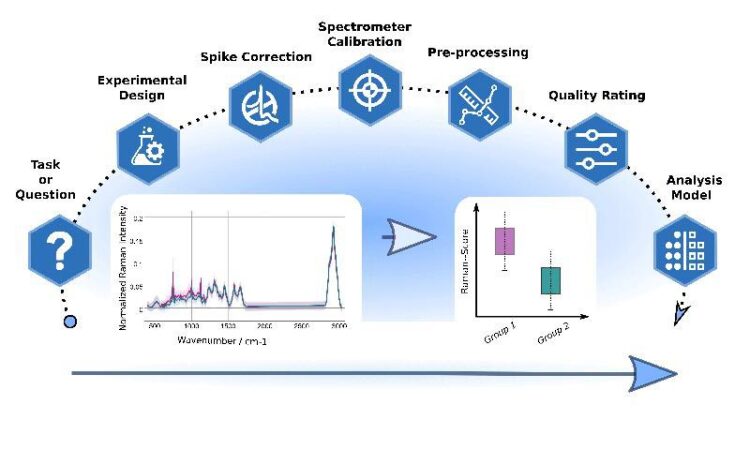Artificial intelligence for better diagnostics

Instructions for standardized Raman spectral analysis
Credit: Thomas Bocklitz / Leibniz-IPHT
Standardized methods facilitate the evaluation of Raman spectra.
Light-based methods are increasingly used for analytical problems in the fields of health, environment, medicine and safety. Raman spectroscopy is a suitable method in this context. The measurement data collected in this process are complex and extensive molecular fingerprints. Artificial intelligence can help in the analysis of these complex Raman spectra. There are still no established standards for the analysis, which makes it difficult to apply in medical or biological settings. A team of researchers from the Leibniz Institute for Photonic Technologies (Leibniz IPHT) and Friedrich Schiller University in Jena, Germany, have developed a guide for Raman spectral analysis.
Raman spectroscopy can be used to determine the molecular fingerprint of samples. This allows, for example, to distinguish materials based on their specific chemical composition. It is also possible to identify pathogens or detect diseased tissue. The signals to be detected and signal differences within the measurement data are minimal and are influenced by numerous factors. Machine learning – artificial intelligence (AI) – methods are used for the evaluation. “In order to help Raman spectroscopy achieve a breakthrough in applications, standardized workflows are needed that deliver results that are as robust as possible,” says private lecturer Dr. Thomas Bocklitz, head of the Photonic Data Science research department at Leibniz IPHT as well as University of Jena. So far, however, there are no established unified standards for the analysis process of Raman spectra.
In a paper recently published in Nature Protocols, Bocklitz and colleagues for the first time provide guidance for the analysis of Raman spectra, covering all steps from experimental design and data preparation to data modeling and statistical analysis, while also pointing out potential pitfalls and how to avoid them. In doing so, the physical chemist was able to draw on his many years of experience in developing and refining data-driven methods. In the meantime, his team has become one of the leading international research groups working on the computer-aided evaluation of Raman spectra at the conceptual level. The close cooperation with the research department Spectroscopy/Imaging at Leibniz IPHT headed by Prof. Jürgen Popp has proven to be an advantage by contributing their expertise in the field of Raman spectroscopy for analysis and diagnostics in the fields of medicine, life and environmental sciences, quality and process analytics, and pharmaceuticals to the joint project.
The researchers from Jena want to contribute to standardized Raman spectral analysis with the published guidance. Together with partners from other research institutions, the next step will be to focus the methodology on instrument intercomparability through a joint ring trial by exploring methods to correct for instrument dependence. Finally, scientists at Leibniz IPHT and the University of Jena plan to use the standardized methods for AI-based evaluation of Raman spectra to develop market-ready light-based diagnostic methods and novel therapeutic approaches at the future Leibniz Center for Photonics in Infection Research in Jena.
Leibniz Institute for Photonic Technologies
Light is at the center of research at Leibniz-IPHT. Scientists are researching innovative photonic processes and tools for use in clinical diagnostics, such as infection and cancer diagnostics, pharmacy and process control, and food and environmental safety. A key goal is to accelerate translation: the translation of research results into practice – from Ideas to Instruments.
Wissenschaftliche Ansprechpartner:
Priv.-Doz. Dr. rer. nat. Thomas Bocklitz
Head of Leibniz-IPHT department “Photonic data science” &
Head of IPC junior research group “Statistical Modelling and Image Analysis”
http://orcid.org/0000-0003-2778-6624
Leibniz Institute of Photonic Technology (Leibniz-IPHT)
Institute of Physical Chemistry and Abbe Center of Photonics (IPC),
Friedrich-Schiller-University
thomas.bocklitz@leibniz-ipht.de
+49-(0)3641-9-48328
Originalpublikation:
Guo, S., Popp, J. & Bocklitz, T. Chemometric analysis in Raman spectroscopy from experimental design to machine learning–based modeling. Nat Protoc 16, 5426–5459 (2021). https://doi.org/10.1038/s41596-021-00620-3
Media Contact
All latest news from the category: Physics and Astronomy
This area deals with the fundamental laws and building blocks of nature and how they interact, the properties and the behavior of matter, and research into space and time and their structures.
innovations-report provides in-depth reports and articles on subjects such as astrophysics, laser technologies, nuclear, quantum, particle and solid-state physics, nanotechnologies, planetary research and findings (Mars, Venus) and developments related to the Hubble Telescope.
Newest articles
Faster, more energy-efficient way to manufacture an industrially important chemical
Zirconium combined with silicon nitride enhances the conversion of propane — present in natural gas — needed to create in-demand plastic, polypropylene. Polypropylene is a common type of plastic found…

Energy planning in Ghana as a role model for the world
Improving the resilience of energy systems in the Global South. What criteria should we use to better plan for resilient energy systems? How do socio-economic, technical and climate change related…

Artificial blood vessels could improve heart bypass outcomes
Artificial blood vessels could improve heart bypass outcomes. 3D-printed blood vessels, which closely mimic the properties of human veins, could transform the treatment of cardiovascular diseases. Strong, flexible, gel-like tubes…





















